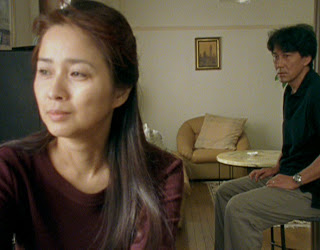As much as I enjoy J Horror I don’t want to stray too far
from the subject of The Midnight Room.
With Séance, Kiyoshi Kurosawa’s 2001
television film based on the Mark McShane novel, Séance on a Wet Afternoon, I think an exception can be made. The original 1964 British film starring Kim Stanley and
Richard Attenborough may already be known to fans of classic Gothic thrillers.
Briefly, the original story concerns a medium who strives
for validation by coercing her husband into kidnapping a little girl whom she
will then “find” through her psychic powers. While the original is certainly
fodder for the psychological exploration of the two main characters, Kurosawa
reinterprets the character of the wife and medium, Junco Santo, as a woman frustrated
by living in the shadow of her more successful husband. Kurosawa adds an
interesting new subplot: a child molester is the one who attempts to kidnap a
charming little girl in a vibrant green dress. The child manages to escape and
hides inside an empty equipment trunk belonging to Junco’s husband, a sound
recording engineer who, not knowing the girl is inside, locks the trunk and
takes it back to his home in the city.
Junco has been working with a young university student
hoping to prove his theory that psychics are of value in police work. The
police seek her assistance in discovering the whereabouts of the missing girl.
It’s a fairly contrived plot development that the missing girl just happens to
be in a trunk on the floor in the garage...and unfortunately not the film’s only
plot hole. Though still alive, the couple conspires to take the girl to an
abandoned location and ultimately Junco will “find” her using her psychic
powers.
Well, you guessed it. Plots of this sort always go horribly
wrong and next thing you know the child dies and her ghost torments her accidental
murderers in true Japanese style, complete with long black hair covering her
face.
Next to Hideo Nakata (Ringu,
Dark Water), Kiyoshi Kurosawa is one
of Japan’s leading horror film-makers, but like Western directors such as
Alfred Hitchcock whose name is synonymous with horror on the strength of only
two films in his oeuvre, Kurosawa’s films transcend the confines of the horror
film by nature of their psychological elements. Séance, Charisma, Pulse, Doppelganger, and my personal favorite, Cure, are all outstanding examples of Kurosawa’s style. His framing
is formal, but what is left outside the frame is often more important than what
the camera sees. The same holds true for his scripts. The screen stories have
an unnerving sense of ambiguity, which brings to mind Nicholas Roeg’s adaptation
on Don’t Look Now. Though the visual
aspect of Kurosawa’s films are devoid of luscious Gothic eye candy, they manage to be bleak and moody, and at
their core are disturbing psychological thrillers involving any number of
paranormal element and thus deserve a special place upstairs in The Midnight Room.





No comments:
Post a Comment